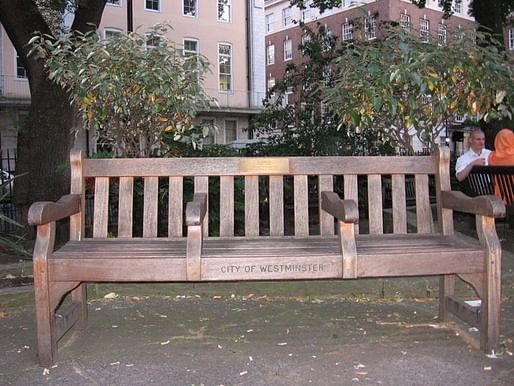
As the number of homeless people in America’s major cities has increased, so have ordinances criminalizing homelessness and pushing homeless families and individuals into the criminal justice system. Criminalization has become a tactic with which politicians have reconfigured cities to serve wealthier citizens and tourists, at the considerable expense of the poor. — Al Jazeera
Of course, urban spaces are often "cleansed" of homelessness through design. Recently in London, metal spikes were set into the ground of an alcove of a new apartment complex to prevent people from sleeping there. After almost 130,000 people signed a petition, they were removed. This followed a similar incident at a London supermarket on expensive Regent St.

Benches are often designed with armrests or sloped centers to make sleeping on them uncomfortable or impossible. This is usually seen as a strategy against homeless or otherwise itinerant peoples. Other times, benches are designed specifically to prevent skateboarders from grinding on them.

Recently, architecture and design that is used to enforce standards of behavior have been dubbed "Disciplinary Architectures." There is, of course, a long history of using architecture as a means to enforce social standards and control the body. One translation of the etymology of the word "architecture" could even be interpreted as a nominal mark of the inheritance of this idea for architecture (arché "ruling" + tekton "structure"). The Ancient Greeks had specified areas of both the house and the city explicitly and strictly segregated by gender. Jumping forward a few thousand years, one of the most (in)famous modern examples of disciplinary architecture is the use of wide streets to prevent barricading in Baron Haussmann's redesign of Paris.
These acts of territorialization – of designating and segregating sections of the city for use by only certain demographics – have been increasingly met with countermoves and strategies. The Vancouver-based non-profit RainCity Housing designed benches that serve as temporary shelters and listed the address of their permanent shelter, which we featured in brief the other day.

Sarah Ross designed jumpsuits with foam forms that turn an anti-homeless bench into a comfortable bed:

The confluence of legal, social, and design practices used to exclude certain demographics from public places form a frightening and powerful force. The two (inclusionary) designs briefly showcased above are just some of many innovate practices engaging with homelessness and other social issues. In many projects like this, the rhetoric of their designs are as important as their actual use-value. For as much as it is important (in my opinion) to develop inclusionary designs, it is just as important to build more nuanced thinking about the causes and realities of homelessness, both in the US and worldwide.
2 Comments
These showed up in Montreal as well and caused a stir. Its sad to see how many homeless people there are there.
Interesting to contrast this with Seatlle Public Library. The latter being a generous extension of the pithy public space within an institutionally private realm (with guards, employees, etc) , the former being the encroaching-essentially- privatization/institutionalization of the public space in the sense where the authority is the institution and not the public.
Yes, but I was also referring to Canada, which is supposed to have more of a socialist system - although there is a definite move away from socialism. Quebec, which is much more socialist in outlook that the other anglophone provinces, itself is gravitating away from a culture of social aid. There have been cuts in many programs. And Im sure more to come, what with the Liberal party taking over. Yes, there are many out on the street, people with mental problems, young people...Things not looking so good.
Block this user
Are you sure you want to block this user and hide all related comments throughout the site?
Archinect
This is your first comment on Archinect. Your comment will be visible once approved.